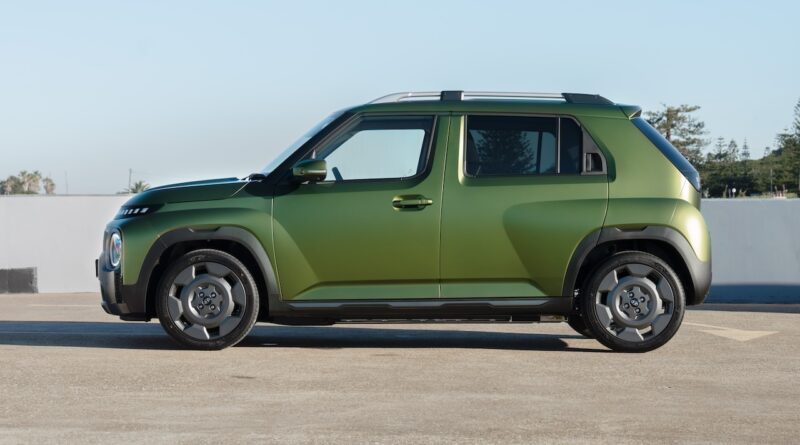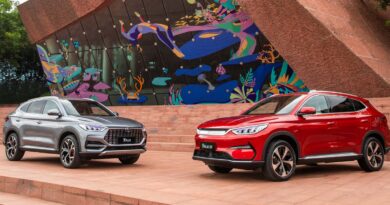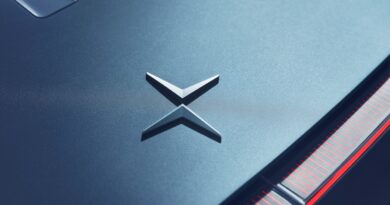Deflated: With no rear airbags the new Hyundai Inster EV is expected to cop a four star ANCAP safety rating
The new Hyundai Inster electric SUV is set to be another point of contention between the Korean auto giant’s Australian arm and the independent safety authority ANCAP (Australasian New Car Assessment Program).
The tiny but expensive Inster – it’s 3.8 metres long and has a $39,000 (plus on-road costs) starting price – comes to Australia without any airbag protection for rear-seat passengers.
That almost assuredly means the Korean-built Inster will be at best awarded a four star rating when results of its testing program are soon announced, rather than the maximum five stars ANCAP campaigns for all vehicles to achieve.
READ MORE: Price fighter: Hyundai Elexio medium electric SUV headed to Australia from China as BYD Sealion 7 and Tesla Model Y rival
READ MORE: Diesel out. EV later. PHEV in! Hyundai finally firms up its dual cab ute plans for Australia
READ MORE: Hyundai Inster priced: It’s the cheapest non-Chinese EV you can buy in Australia today, but still $10K more than a BYD Dolphin
That means EVs with up to $10,000 cheaper starting prices, the BYD Dolphin, GWM Ora and MG4 will all outdo the Inster as they have five star ratings.
A four star star rating will effectively lock Inster out of the government fleet market, although just how much volume that would have amounted to is unknown.

“ANCAP has been encouraging the fitment of side head-protecting airbags for first and second row seating positions for close to 10 years, so it is disappointing to see any new model enter the market without this important, and potentially life-saving feature,” ANCAP chief executive officer Carla Hoorweg told EV Central via an emailed statement.
This is not the first time Hyundai and ANCAP have been involved in a star rating debate.
ANCAP chastised Hyundai when the latest Kona compact SUV, including the electric version, achieved only a four star rating in 2024.
Hyundai Australia COO John Kett (who now works at GWM Australia) defended the score at the time, arguing the four star Kona was safer than an older five star car because it was tested to tougher ANCAP protocols.
[Kona is] certainly a four-star car and that’s totally accepted,” said Kett. “But… a four-star 2023 protocol is significantly safer than 2022-21-20 five-star.

“So… I can’t buy this car because it says four but I can buy this car because it says five… So you sit there scratching your head, but you just have to accept it.”
Not long after that ANCAP tested the Hyundai i30 sedan and awarded it only three stars. It did so without the co-operation or involvement of Hyundai in any substantive way, which is unusual.
In this case, Hyundai has declined to comment until results are issued. It has instead supplied a list of the substantial safety kit the Inster has standard including autonomous emergency braking, adaptive cruise control, various lane keeping assists, rear cross traffic avoidance, blind spot collision avoidance, tyre pressure monitoring, traffic sign recognition and driver monitoring. The LED headlights have auto high beam adjust.
The flagship $45,000 Inster Cross alone gets a surround view monitor, blind spot view monitoring, parking collision avoidance, an electrochromatic mirror and front parking sensors.
All Insters come with front, front-side, front-curtain and centre-front airbags.
Inster is being tested by ANCAP’s European sister organisation, EuroNCAP, and local ratings will be adapted from those results.
In its public statements, EuroNCAP is more accepting of four star results than ANCAP.

ANCAP ratings are based on assessments across four categories – adult occupant protection, child occupant protection, vulnerable toad user protection and safety assist.
The process includes crash testing and driver assist system assessment. The weakest score across the four test categories determines the overall star rating.
The lack of head-protecting airbags in Inster for second-row outboard seating positions will result in a scoring deduction in the oblique pole impact assessment that simulates severe side impacts.
This deduction is equivalent to 12.5 per cent of the total points available in the pole impact assessment, and is designed to reflect the increased risk of injury to rear occupants in the absence of head-protecting airbags.
This factors into the overall adult occupant protection score.
- Watch out for our review of the Hyundai Inster, coming soon.




